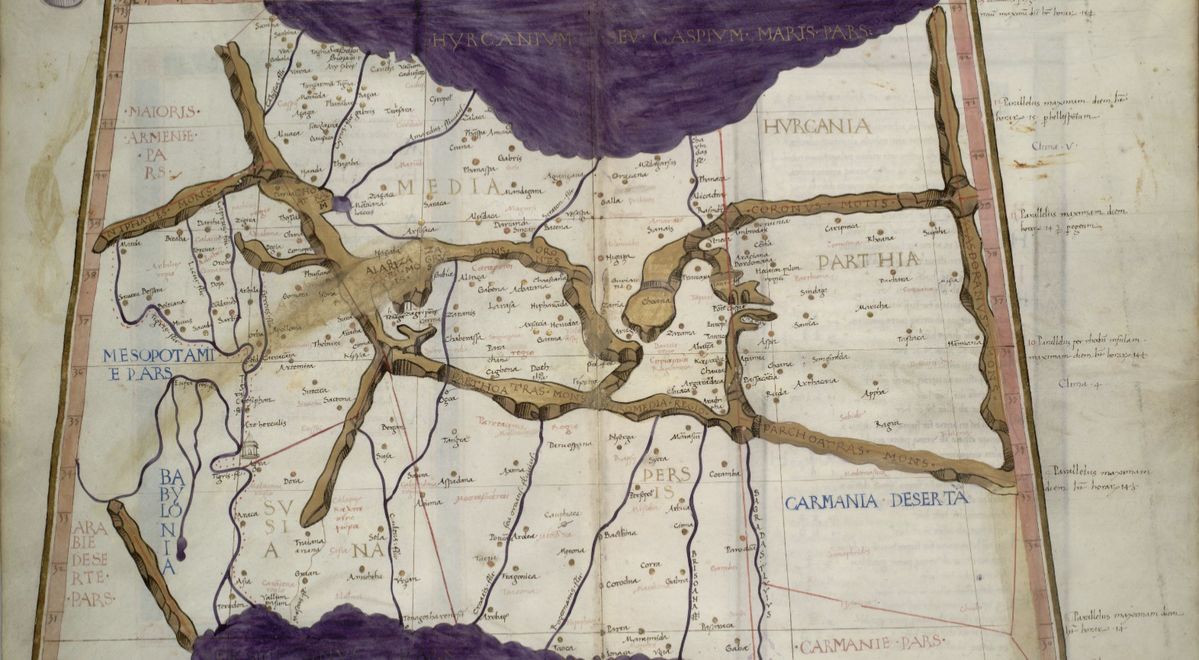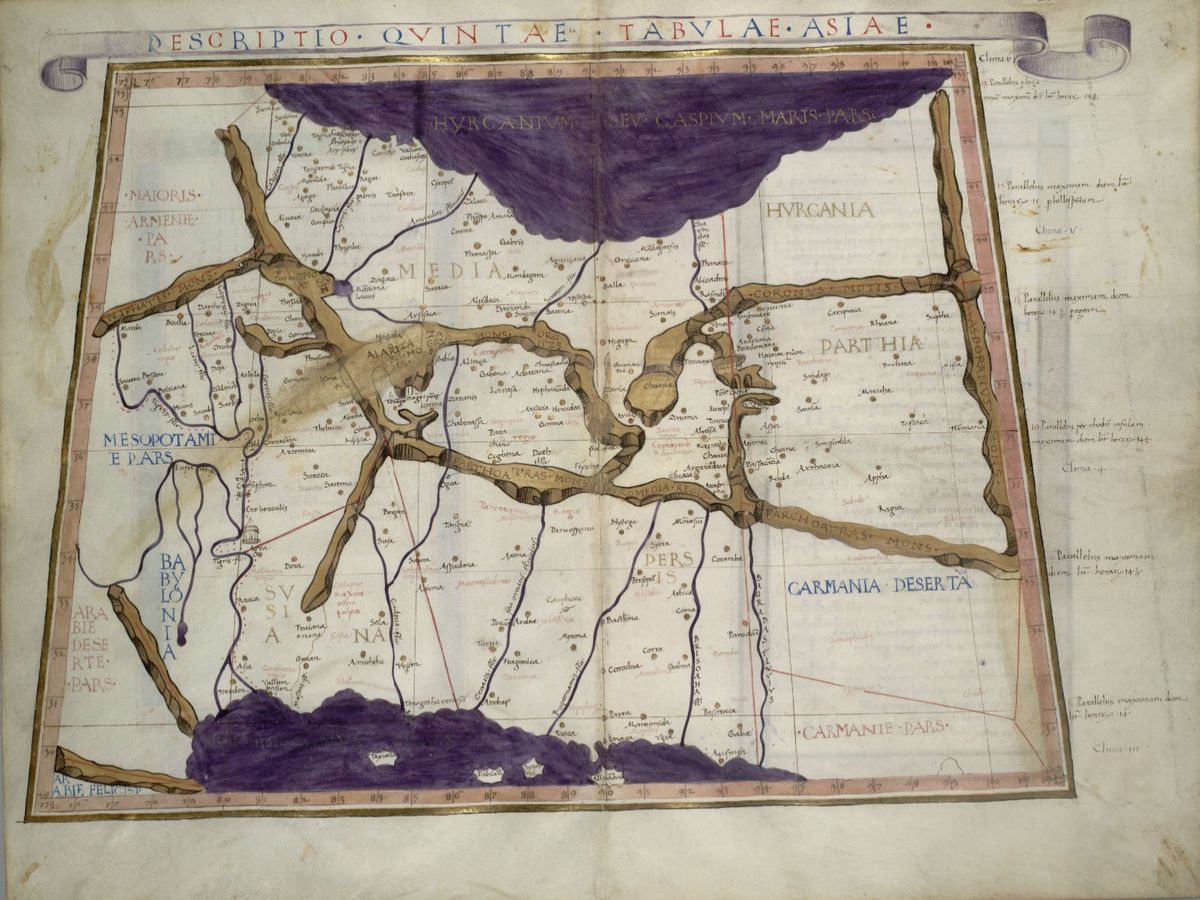
The Pursuit of Hecatompylos: A Persian Capital in the Early Modern English Mind
Nonnullas autem nunc longe aliter quam olim habere, vel propter particulares earum devastationes, vel etiam immutationes. Unde necesse est, ut ibi nouissimis temporis nostri traditionibus, penitus quasi adhaereamus, observantes obiter et historiae antiquae expositionem, necnon praedictorum diiudicationem, ut liquere possit, quid fide dignum quidue sit erroneum.
Other parts of the earth are different to-day from what they were, either on account of revolution or transformation, in which processes they are known to have partially passed into ruin. We consider it necessary therefore for us to pay more attention to the newer records of our time, weighing, however, in our description these new records and those of former times and deciding what is credible and incredible. [1]
Ptolemy states this near the beginning of his Geographica, explaining that whilst some lands are now very different to what they have been in the past, it is only through an exploration and judgement of history that we can be clear as to what is trustworthy and what is erroneous. Early modern English travellers to Isfahan engaged with a similar quandary: whether to represent this new Persian capital as a city which had only recently been re-established; or to attempt to connect it to names which appear in classical Greek geographies.
What is in a name? Why does it matter what early modern travellers called the places they visited? Well, often names are used ideologically, to supplant, erase, or give provenance [2]. The names these travellers used or proposed conveyed their own struggle with understanding the rise of a new Persian power, without letting go of their own classical knowledge.
In the late 1590s, the city of Isfahan became the foremost metropolis in the Safavid Empire. Shah Abbas I made it his capital and instigated a series of architectural and cultural projects that would situate the city as an important node on a network of trade stretching from Luzon to London. When English travellers made their way to the new Persian capital in the late 16th and early 17thcenturies, they found themselves attempting to come to terms with its power and nascence, an intrepid exploration that for most of these travellers, meant attempting to piece together classical geographies. For them, for a city to claim any semblance of ‘greatness’,it must have an established genealogy.
The first Englishman to discuss the potential origins of Isfahan was John Cartwright, a traveller-cum-preacher-cum-East India Company wannabe. On his travels to Persia in 1600, he writes that: “Sure it is, that in times past it was called Ecatompolis, the Citie of a hundred gates” [3]. This name, variously recorded as ‘Ecatompolis’ or ‘Hecatompylos’, comes up in most early modern discussions of the origin of Isfahan. Thomas Herbert wrote similarly in 1634 that Isfahan “was called by the ancient GreeksHecatompilos, from its hundred gates” [4] and in the 1638 edition of his Some Yeares Travels, attributes this name to “Apollodorus, Polibius, Ptolomy, and Pliny”. Herbert does not attribute his claim to any sources in the first edition of his text.
If we take a close look at the sources Herbert cites, we find some discrepancies. In Apollodorus of Artemitia, we find that the only mention of a ‘Hecatompylos’ is actually in a quote in Strabo’s Geographica, which states that “the distance from the Caspian Gates to Rhagae is five hundred stadia, as Apollodorus says, and to Hecatompylus, the royal seat of the Parthians, one thousand two hundred and sixty” [5]. If we use Hansman’s 1968 calculations that one stade according to Apollodorus equalled 163 metres, then this would mean that the distance from the Caspian Gates to Rhagae, whose ancient ruins are located north-east of Rey, near Tehran, would be 81.5 kms, and the distance to Hecatompylos would be 205kms. If we identify that Apollodorus was judging the distance from the Caspian Gates to Hecatompylos through Rhagae, then this would mean that the distance between Rhagae and Hecatompylos would be 125.5kms. This would seem to discount Isfahan as a potential location of Hecatompylos, as the city is located 327kms from Rhagae. If we identify the Caspian Gates as Kuh-i Namak in the Elburz Mountains, as Hansman does, we find that it much further than 205kms from Isfahan, further disproving any potential correlation between Isfahan and Hecatompylos. Even with any other potential location for the Caspian Gates, such as those in the Zagros, eastern Anatolia, the Caucasus, or even on the eastern side of the Caspian Sea, they would all be much more than 205kms from Isfahan.
So then what is this Hecatompylos that early modern travellers write so much about? And perhaps more importantly, where is it?
Polybius situates Hecatompylos around north-western Iran, in “the centre of Parthia” [6]. Whilst Isfahan could be situated in Parthia by an unknowing English (or Greek) eye, it is much more on the western outskirts of the region, than in the centre. In reference to the satrapies used by the Achaemenids and Seleucids, which would have been the regions referred to by the classical Greek authors, Isfahan would have been situated in Media, rather than Parthia. Ptolemy and Pliny both identify Hecatompylos as the capital of the Parthians. However, as Hansman notes in his discussion of the location of the city, both acknowledge earlier authors who have conflicting views on the location of the city [7]. Therefore, it is unlikely that Hecatompylos and Isfahan are the same city.
Herbert, like Cartwright, confuses Hecatompylos and Isfahan. He even calculates the distance between Isfahan and the Caspian Sea relatively accurately, noting that it is 118 parasangs, or 354 English miles [8]. So if Herbert could calculate this distance fairly accurately, why could he not recognise that the distances Apollodorus gives are so off for Hecatompylos to be Isfahan?
Cartwright and Herbert both take Ptolemy’s advice, searching through the histories and geographies that they were aware of in an attempt to judge the truth. In the process, they connect Isfahan with cities such as Hecatompylos and Ectaban which have long, established histories as capitals of the Parthians and Medians respectively. These are names which their audience could look up in their copies of Ptolemy and Herodotus and visualise the routes of these early modern travellers. However, through questioning these associations, Cartwright and Herbert inscribe their own names and experiences into the records of histories and geographies on Persia.
Ectaban is another name floated by Herbert, even though he believes the association to be “ridiculous”. Ectaban, the former ancient capital of Media, is now associated by most scholars with the modern Persian city of Hamadan. However, the site of Hecatompylos is much more contested. Most scholars who have searched the north-eastern deserts of Iran believe that it is located somewhere between Damghan and Semnan (perhaps Shahr-i Qūmis) [9]. These are based on the distances given in Strabo’s Geography. However, even in this text, both Apollodorus of Artemita and Eratosthenes give different measurements of the distance of Hecatompylos from the Caspian Gates (1260 and 1960 stadia respectively). Shahr-i Qūmis fits with Apollodorus’ distance, but not with Eratosthenes’. However, as Hansman wrote in 1981, “the evidence tends to support the probability that Shahr-i Qūmis represents the site of ancient Hecatompylos” [10]. Herbert eventually comes to the same conclusion in the 1638 edition of his text, writing that “I think this City was never named Hecatompylon” [11] and instead is one of the first in England to associate Isfahan with Aspadana, which appears in Ptolemy’s Geographica as a city in the region of Persis. This is an association which is also visible in early modern maps of the region based on Ptolemy’s Geographica, such as this example from the Huntington Library from c. 1480 [12], which relates map 5 of Asia as in the Geographica (I have underlined the cities of Aspadana (bottom centre) and Hecatompylon Regia (top right) as they appear on the map):

Here, Aspadana is located much closer to the location of Isfahan, and Hecatompylos can be seen in the top right as Hecatompylon Regia.
By the 1677 edition of his Some Yeares Travels, Herbert utilises more sources, even citing an Arabic geographer, who names the city “Asbahawn” [13]. For Herbert, Isfahan’s pedigree lies in these histories, and his exploration of it is justified by the established presence it has in classical histories of the Persian region.
So what’s in a name? Herbert noticed the discrepancy between Hecatompylos and Isfahan, correcting Ptolemy and pre-empting a modern scholarly debate on the location of this same city based on the calculation of stadia in Ptolemy. Herbert partakes in exactly what Ptolemy suggests in the first book of his Geographica. He examines the histories that have come before him and adapts and judges what is true and what is not. In his examination of the naming conventions of Isfahan, Herbert questions the classical Greek texts which form so much of the base of his pre-conceptions of Persia.
In a similar fashion, we too, as explorers of the histories of the past, have this same employment. Our role is to question, to realise that these places with which we engage have gone through immense changes. We must both engage with the temporis nostri traditionibus, the traditions of our time, as well as those that have come before us, to clarify what we can trust and what we cannot. Perhaps, in a sense, we’re not so different to these early modern travellers, attempting to make sense of our historic predecessors.
Author:
William Perry is a PhD Candidate at University College Dublin. His work focuses on the spaces of inter-cultural interaction within Safavid Persia. He is currently in the final stages of writing his thesis, entitled Travel and Transculturality: Centring Isfahan in Early Modern Travel Writing and Drama.
Sources:
[1] Ptolemy, Geographica (Venetiis: apvd Vincentivm Valgrisvm, 1562), 32.
Translation: Ptolemy, The Geography, trans. Edward Luther Stevenson (New York: Dover Publications, 1991), 28/29.
[2] Matthew Fletcher, "The Cardinal Importance of Names." Aries (Leiden: Netherlands) 21, no. 1 (2020): 123.
[3] John Cartwright, The Preacher’s Travels (London: Printed for Thomas Thorppe) 60
[4] Thomas Herbert, Some Yeares Travels (London: Printed by Will Stansby and Iacob Bloome, 1634) 82.
Thomas Herbert, Some Yeares Travels (London: Printed by R. Bishop for Iacob Blome and Richard Bishop, 1638) 154.
[5] Strabo, The Geography of Strabo, trans. Horace Leonard Jones (London: William Heinemann LTD, 1961) 11.IX.I
[6] Polybius, Histories, Trans. Evelyn S. Shuckburg. (London: Macmillan, 1889) X.28.
[7] John Hansman, “The Problems of Qūmis”, Journal of the Royal Asiatic Society, Vol.100, Issue 2, April 1968, pp. 115.
[8] Thomas Herbert, Some Yeares Travels (London: Printed by Will Stansby and Iacob Bloome, 1634) 143.
[9] Getzel M. Cohen, The Hellenistic Settlements in the East from Armenia and Mesopotamia to Bactria and India (Berkeley: University of California Press, 2013) 245.
[10] John Hansman, “The Measure of Hecatompylos”, The Journal of the Royal Asiatic Society of Great Britain and Ireland, 1981, No.1, pp. 5.
[11] Thomas Herbert, Some Yeares Travels (London: Printed by R. Bishop for Iacob Blome and Richard Bishop, 1638) 154.
[12] HM 1092 (Ptolemy, Geographica), Huntington Library, San Marino, CA, f. 39v – 40r, c. 1480.
[13] Thomas Herbert, Some Yeares Travels (London: Printed by R. Everingham, for R. Scot, T. Basset, J. Wright, and R. Chiswell, 1677) 160.
